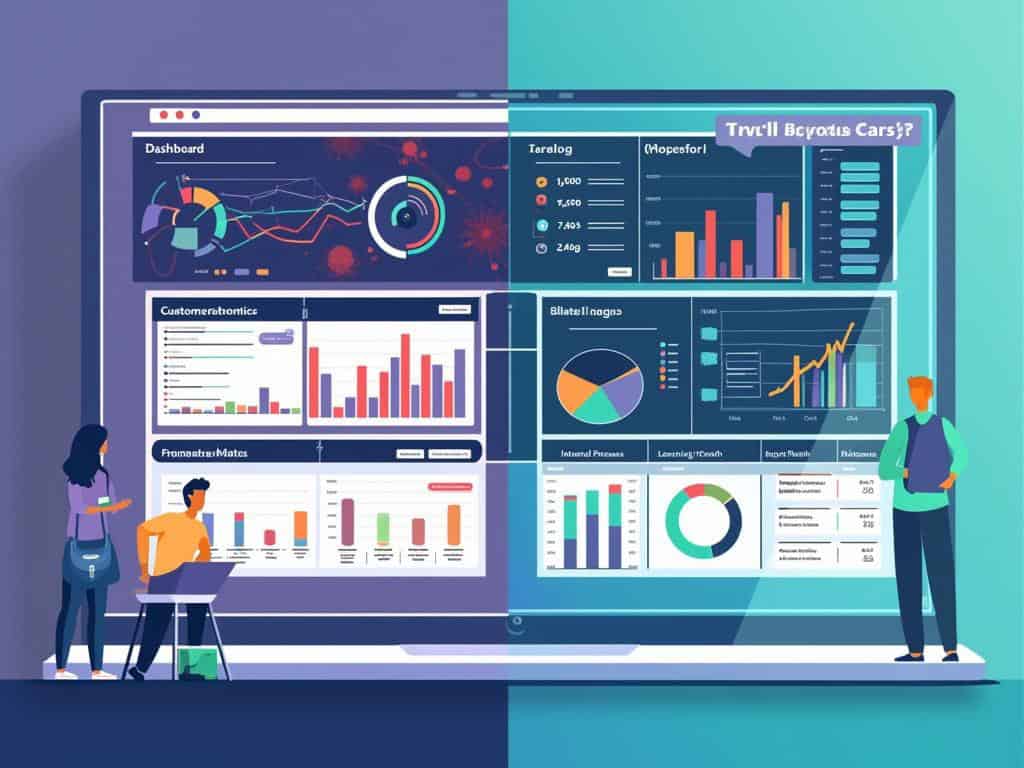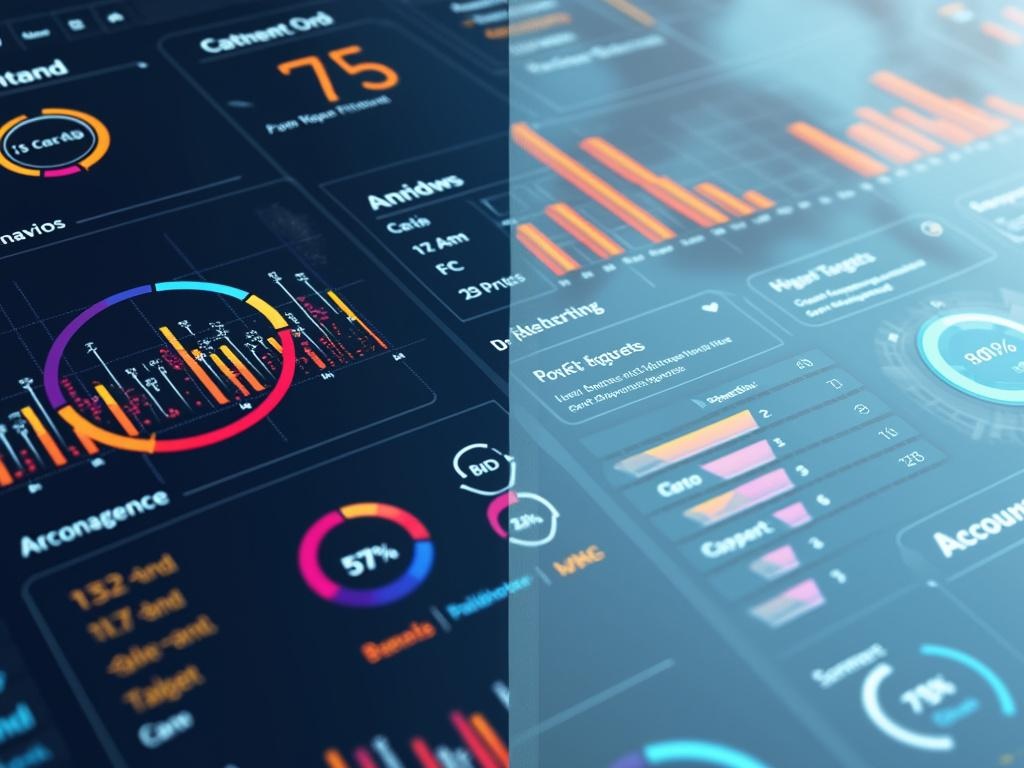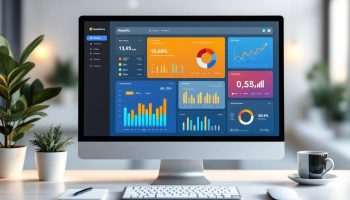
Understanding the Dashboard vs. Scorecard Distinction
In performance management, recognizing the differences between dashboards and scorecards helps organizations gain complete insights into their operational and strategic performance. These two tools offer distinct approaches to tracking and analyzing business metrics – dashboards provide real-time operational snapshots while scorecards deliver strategic goal tracking across multiple perspectives.
Key Takeaways:
- Dashboards focus on real-time, operational metrics with continuous updates, while scorecards track strategic progress at less frequent intervals.
- Dashboards are primarily used by operational and middle management, whereas scorecards target executive leadership.
- The Balanced Scorecard methodology provides a structured approach to measuring performance across four key perspectives.
- Both dashboards and scorecards are complementary tools that serve different but essential performance management functions.
- Effective implementation requires understanding the specific needs and goals of your organization.
Dashboards deliver immediate operational visibility through dynamic, data-rich displays. They update continuously and allow managers to monitor performance indicators in real-time. This gives you the ability to quickly identify issues and make operational adjustments as needed. Many organizations use business intelligence dashboards to visualize complex data in accessible formats.
Scorecards, by contrast, take a broader strategic view. They track progress toward long-term objectives across different business areas. The balanced scorecard approach examines financial metrics alongside customer satisfaction, internal processes, and learning/growth indicators. This comprehensive perspective helps leadership connect daily operations to strategic goals.
Your choice between these tools depends on specific needs. Operations teams benefit from dashboards’ immediate feedback, while executives gain more value from scorecards’ strategic alignment capabilities. Most organizations find that combining both approaches creates the most robust performance management system.
“Mastering the distinction between dashboards and scorecards is essential for organizations to unlock the full potential of their performance management strategies. By leveraging these complementary tools—dashboards for real-time insights and scorecards for strategic tracking—businesses can navigate their operational landscape with clarity and purpose.”
Defining Performance Management Tools
Performance management tools have evolved significantly, with dashboards and scorecards emerging as two distinct yet complementary approaches for tracking business performance. Understanding the differences between dashboard vs scorecard capabilities helps you make informed decisions about which tool best suits your specific needs.
Dashboards function as real-time visual performance monitoring tools that provide immediate insights into operational metrics. They consolidate multiple KPIs into accessible visual formats like charts, graphs, and gauges, enabling quick assessment of current performance status. You’ll find dashboards particularly valuable for day-to-day decision making and spotting operational anomalies as they occur.
Scorecards, by contrast, serve as strategic goal tracking and management instruments focused on measuring progress against predefined objectives. They typically align with the Balanced Scorecard methodology, which examines performance across four key perspectives: financial performance, customer insights, internal processes, and learning and growth. Unlike dashboards, scorecards update less frequently—weekly, monthly, or quarterly—making them better suited for strategic planning and strategic decision-making processes.
The key distinctions between dashboard vs scorecard approaches include:
- Time orientation: Dashboards focus on real-time or near real-time data, while scorecards track progress over longer periods
- Management level: Dashboards serve operational teams and middle management, while scorecards target executive leadership
- Purpose: Dashboards monitor current operations, while scorecards measure strategic goal achievement
- Update frequency: Dashboards refresh continuously or daily, while scorecards update at scheduled intervals
Choosing Between Dashboard vs Scorecard Approaches
When selecting performance management tools, consider how your organization can benefit from both dashboard vs scorecard methodologies. The ideal approach often combines both tools to create a comprehensive performance management system that addresses both operational and strategic needs.
This table summarizes the key differences between dashboard vs scorecard approaches:
| Feature | Dashboard | Scorecard |
|---|---|---|
| Time focus | Real-time/current | Strategic/long-term |
| Primary users | Operational staff, middle managers | Executives, strategic planners |
| Update frequency | Continuous/daily | Weekly/monthly/quarterly |
| Key purpose | Monitor operations, detect issues | Track strategic goal progress |
| Visualization style | Dynamic charts and gauges | Progress indicators against targets |
By understanding the dashboard vs scorecard distinction, you can implement more effective performance review processes and ensure your organization remains both operationally efficient and strategically focused.

Real-Time Operational Insights: Understanding Dashboards
Dashboards provide a comprehensive operational snapshot of your business performance through visual representations that consolidate multiple KPIs and metrics. When comparing dashboard vs scorecard approaches, dashboards excel at delivering immediate, actionable data for daily operations.
Your dashboard serves as the nerve center for operational monitoring, displaying critical information through charts, graphs, and gauges. Unlike scorecards that focus on strategic objectives, dashboards update in real-time or near real-time, making them ideal for short-term decision making and instant performance tracking. The dashboard vs scorecard distinction becomes clear when examining their update frequency and primary users.
Essential Dashboard Characteristics
The key elements that distinguish dashboards in the dashboard vs scorecard comparison include:
- Real-time data updates that show current operational status
- Visual representations optimized for quick comprehension
- Operational metrics focused on immediate performance indicators
- Anomaly detection capabilities for early problem identification
- User interfaces designed for low to middle-level management
Dashboards primarily support your daily operational decisions rather than long-term strategic planning. This makes them complementary to scorecards in a complete performance management system that drives organizational success.
The following table illustrates the primary differences between dashboards and scorecards:
| Feature | Dashboard | Scorecard |
|---|---|---|
| Time Focus | Current/Real-time | Historical/Strategic |
| Update Frequency | Minutes/Hours | Weekly/Monthly/Quarterly |
| Primary Users | Operational Managers | Executives/Strategic Leaders |
| Key Purpose | Operational Monitoring | Strategic Goal Tracking |
| Data Presentation | Highly Visual | Measurement Against Targets |
Implementing effective dashboards requires careful consideration of the metrics that matter most to your operational teams. By selecting the right KPIs and presenting them visually, you can enhance your project management effectiveness and maintain operational control.
Your dashboard vs scorecard strategy should align with organizational needs. While dashboards excel at showing what’s happening now, scorecards provide the strategic context of why it matters in the bigger picture. This distinction makes both tools essential for complete performance management, with dashboard vs scorecard considerations forming the foundation of your monitoring approach.
Expert Insight: To optimize your real-time operational insights, focus on selecting the right KPIs that resonate with your daily operations when designing your dashboard. Ensure that the visual elements are intuitive, enabling quick comprehension for low to middle-management users who rely on this data for immediate decision-making. By leveraging the strengths of both dashboards for current performance monitoring and scorecards for strategic oversight, you can create a comprehensive performance management system that drives success.
Strategic Performance Management: The Scorecard Approach
The scorecard approach represents a critical evolution in how organizations track strategic performance. Unlike dashboards that focus on immediate metrics, scorecards measure progress against predetermined strategic goals. This approach, particularly through the Balanced Scorecard methodology, offers a structured framework for evaluating whether your business is moving in the right direction over time.
The Four Balanced Scorecard Perspectives
A comprehensive scorecard system incorporates these four essential perspectives to provide a balanced view of organizational performance:
- Financial Performance: Tracks revenue growth, profit margins, and return on investment metrics that demonstrate financial health.
- Customer Insights: Measures customer satisfaction, retention rates, and market share to gauge your competitive position.
- Internal Processes: Evaluates operational efficiency, quality standards, and process improvements.
- Learning and Growth: Assesses employee development, innovation capabilities, and organizational culture.
The distinction between dashboard vs scorecard becomes clear when examining update frequency. While dashboards typically refresh in real-time or near real-time, scorecards are updated weekly, monthly, or quarterly to reflect longer-term strategic progress. This timing difference reflects their complementary purposes—dashboard vs scorecard isn’t about choosing one over the other, but understanding how each serves different management needs.
Scorecards excel at strategic planning support, providing executives with the tools to evaluate if initiatives align with organizational goals. They help identify when strategic adjustments are needed by comparing current performance against established benchmarks. Your scorecard metrics should directly tie to corporate objectives, creating a clear line of sight from daily activities to long-term vision.
When implementing a scorecard approach, you’ll need to establish clear ownership for each metric, define update procedures, and create a review cadence with stakeholders. Effective scorecards don’t simply present numbers—they tell the story of your strategic journey using dashboard vs scorecard elements appropriately.
The value of the dashboard vs scorecard differentiation becomes particularly evident during strategic review processes. While dashboards signal immediate operational issues, scorecards reveal whether your strategic initiatives are delivering expected results over time. This longer-term perspective proves essential for sustainable organizational growth and competitive advantage.
Organizations that implement the Balanced Scorecard as their performance management system have seen significant improvements in strategic alignment and goal achievement, with studies showing up to a 50% increase in overall performance indicators.
hbr.org
Comparative Analysis: Dashboards vs. Scorecards
Understanding the distinction between dashboard vs scorecard systems is vital for effective performance management. These two tools serve different but complementary purposes in your organization’s performance tracking arsenal.
Dashboards function as operational monitoring tools that display real-time or near real-time data through visual elements like charts, graphs, and gauges. You’ll find dashboards particularly valuable for day-to-day decision making as they provide immediate insights into operational performance. They’re typically used by frontline and middle managers who need quick access to current performance metrics and rapid anomaly detection.
Scorecards, by contrast, focus on measuring progress against strategic objectives over longer timeframes. When you implement a scorecard system, you’re establishing a framework to compare current metrics with predefined goals, often incorporating the Balanced Scorecard methodology with its four strategic perspectives:
- Financial performance metrics
- Customer insight measurements
- Internal process evaluations
- Learning and growth indicators
The fundamental differences between dashboard vs scorecard approaches can be summarized in the following comparison table:
| Feature | Dashboard | Scorecard |
|---|---|---|
| Update Frequency | Real-time/daily | Weekly/monthly/quarterly |
| Primary Focus | Operational metrics | Strategic objectives |
| Management Level | Low to middle | Middle to executive |
| Decision Context | Tactical, immediate | Strategic, long-term |
| Visual Elements | Dynamic charts, gauges | Progress indicators, comparisons |
For optimal results, you should consider integrating both dashboard vs scorecard tools in your project leadership approach. This combined methodology offers enhanced operational agility while maintaining strategic alignment across your organization. Business Intelligence (BI) platforms like ClearPoint Strategy can facilitate this integration, providing a comprehensive view of both immediate performance and long-term strategic progress.
When implementing these performance tracking tools, you’ll need to establish clear metrics that align with both operational needs and strategic vision. The dashboard vs scorecard distinction becomes particularly important during the planning phase, as each serves different stakeholder needs and timeframes.
By leveraging both dashboard vs scorecard capabilities, you create a multi-layered performance management system that addresses immediate operational concerns while maintaining focus on long-term strategic objectives. This balanced approach ensures your organization can respond to daily challenges without losing sight of its broader mission and goals.
Expert Insight: When leveraging performance management tools, recognize that dashboards are essential for real-time operational monitoring, providing frontline managers with immediate insights to make tactical decisions. In contrast, scorecards are designed to measure and track progress against strategic objectives, facilitating long-term planning and alignment among executive leaders. Integrating both systems within your organization not only enhances agility but also ensures that immediate actions support overarching goals, fostering a comprehensive approach to performance management.
Implementing Performance Tracking Tools
Successful performance tracking requires careful implementation of the right tools. Understanding dashboard vs scorecard distinctions will help you select and deploy the appropriate solution for your organization’s needs.
Integration Strategies
You’ll achieve better results when you integrate dashboards and scorecards within your existing business framework. These tools complement each other—dashboards provide real-time operational insights while scorecards track strategic progress against predefined objectives.
When implementing these performance tracking tools, consider these essential factors:
- Tool selection based on organizational goals
- Data source identification and integration requirements
- User training and adoption planning
- Customization needs for specific departments
- Maintenance and update processes
Several software platforms can support your dashboard vs scorecard implementation needs. Business Intelligence (BI) solutions offer comprehensive capabilities for both tools, while specialized platforms like ClearPoint Strategy provide focused scorecard functionality with strategic planning features.
Effective implementation follows these best practices:
- Start with clear objectives for what you want to measure
- Involve stakeholders early in the design process
- Focus on dashboard vs scorecard distinctions when determining metrics
- Keep initial designs simple and add complexity gradually
- Create a feedback loop for continuous improvement
The combination of dashboards and scorecards delivers significant benefits for project integration management. This dual approach provides enhanced operational agility through real-time dashboard monitoring while maintaining strategic alignment via scorecards.
| Factor | Dashboard Implementation | Scorecard Implementation |
|---|---|---|
| Update Frequency | Real-time or daily | Weekly to quarterly |
| Primary Users | Operations teams | Executive leadership |
| Data Sources | Operational systems | Multiple departments |
| Key Focus | Current performance | Strategic progress |
| Dashboard vs Scorecard Metrics | Operational KPIs | Strategic objectives |
By carefully implementing both dashboard and scorecard solutions, you’ll create a comprehensive performance tracking system that supports both tactical operations and strategic decision-making across your organization.
Transforming Business Performance
Performance tracking tools have evolved dramatically over recent years. You need both operational visibility and strategic direction to effectively manage your business. Dashboard vs scorecard solutions offer distinct approaches to performance management, each serving different yet complementary purposes.
Defining Performance Management Tools
Performance management tools transform raw data into actionable business insights. Here’s how dashboards and scorecards differ:
- Dashboards are real-time visual monitoring tools displaying current operational performance.
- Scorecards track progress against strategic goals and objectives over time.
- Dashboard vs scorecard tools target different organizational levels.
- Both serve to translate complex data into decision-making information.
Dashboards provide comprehensive operational snapshots through visual representations like charts, graphs, and gauges. You’ll appreciate their real-time or near real-time updates when making day-to-day operational decisions. These tools are particularly valuable for preventing post-hoc management by identifying issues as they emerge rather than after they’ve become problems.
Scorecards take a more strategic approach, measuring progress against predefined objectives. The Balanced Scorecard methodology incorporates four key perspectives that give you a holistic view of organizational performance:
| Perspective | Focus Area | Update Frequency |
|---|---|---|
| Financial | Revenue, costs, profit margins | Monthly/Quarterly |
| Customer | Satisfaction, loyalty, market share | Monthly |
| Internal Processes | Efficiency, quality, cycle time | Weekly/Monthly |
| Learning & Growth | Employee skills, innovation | Quarterly |
When implementing dashboard vs scorecard solutions, consider how they complement each other. Dashboards support quick risk response strategies, while scorecards ensure long-term strategic alignment. The frequency of updates differs significantly—dashboards refresh constantly while scorecards update weekly, monthly, or quarterly.
Your implementation approach should integrate both tools for maximum benefit. Many Business Intelligence platforms now offer combined solutions that give you operational agility alongside strategic alignment. This dual approach helps you maintain balance between strategic and operational planning.
Dashboard vs scorecard implementation transforms business performance by connecting daily activities to long-term goals. You’ll see improvements in decision-making speed, strategic alignment, and overall organizational performance when you leverage these complementary tools effectively.






